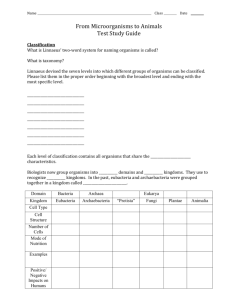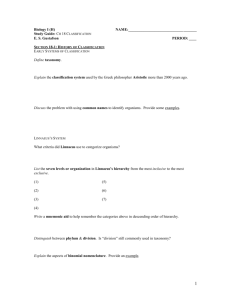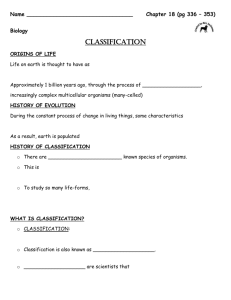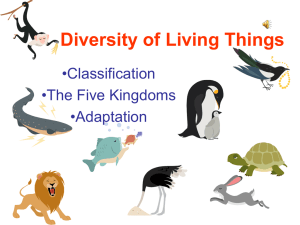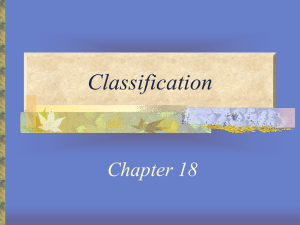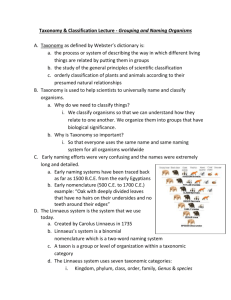Classification
advertisement
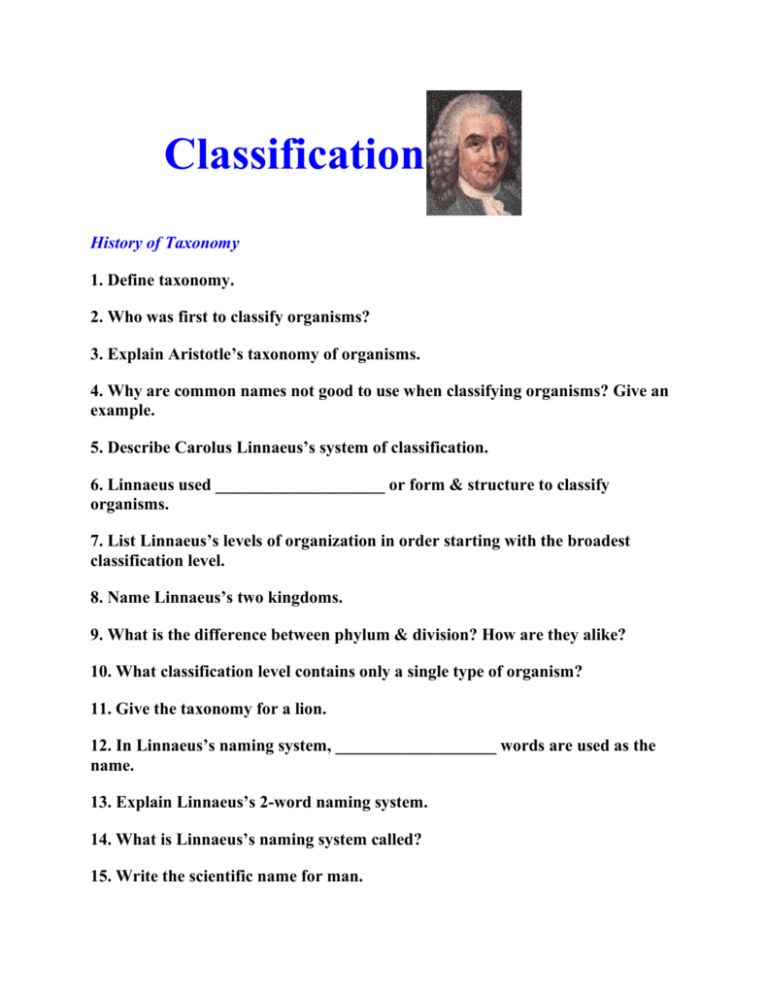
Classification History of Taxonomy 1. Define taxonomy. 2. Who was first to classify organisms? 3. Explain Aristotle’s taxonomy of organisms. 4. Why are common names not good to use when classifying organisms? Give an example. 5. Describe Carolus Linnaeus’s system of classification. 6. Linnaeus used ____________________ or form & structure to classify organisms. 7. List Linnaeus’s levels of organization in order starting with the broadest classification level. 8. Name Linnaeus’s two kingdoms. 9. What is the difference between phylum & division? How are they alike? 10. What classification level contains only a single type of organism? 11. Give the taxonomy for a lion. 12. In Linnaeus’s naming system, ___________________ words are used as the name. 13. Explain Linnaeus’s 2-word naming system. 14. What is Linnaeus’s naming system called? 15. Write the scientific name for man. 16. The ___________ name is written first and must always be __________________. 17. The ____________ name is written second and should _____________ be capitalized. 18. Name 2 things a species name may do. 19. What are varieties? 20. What are subspecies? 21. Write a scientific name that includes a subspecies. 22. What do modern taxonomist use to classify organisms? 23. What is phylogeny? Modern Phylogenetic Taxonomy 24. Name 6 things used by modern taxonomists to classify organisms. 25. Classification of an organism should reflect its __________ or ___________ history. 26. What is systematics? 27. Name a tool used by systematic taxonomists. 28. What is a phylogenetic tree? 29. Draw a phylogenetic tree showing the possible relationships among animal phyla. 30. Do phylogenetic trees ever change? Explain. 31. What complex animal group is located at the top of your phylogenetic tree? 32. Do all organisms have complete fossil records? Explain. 33. Which structures show that organisms are more closely related, homologous or analogous? 34. Features similar in structure but with different functions are called _______________ structures. 35. Early patterns of similar ______________________ development show relationships. 36. The fertilized egg or _______________ divides by mitosis. 37. What is the blastula & make a sketch? 38. What is the blastopore, & what does it become? 39. The blastopore becomes the mouth in many animals except in ________ where it becomes their ______________. 40. What invertebrate group is most closely related to the vertebrates? 41. Taxonomists compare macromolecules such as ____________, ____________, & ____________ to show similarities among species. 42. If two organisms have similar banding patterns on their chromosomes then they are _______________ related. 43. What is used in cladistics to show evolutionary relationships? 44. What is a derived character & give an example? 45. Do shared derived characters show common ancestry? 46. What is a cladogram? 47. Sketch a cladogram for vertebrates. Modern Systems of Classification 48. The discovery of 2 broad types of bacteria led taxonomists to develop what type of classification system? 49. Name the 6 kingdoms & tell which are prokaryotes & which are eukaryotes. 50. Describe members of the kingdom Archaebacteria. 51. In what type of environment are Archaebacteria found? 52. Did Archaebacteria carry on photosynthesis? 53. What kingdom contains true bacteria? 54. Name 4 things Eubacteria do that affect your life. 55. Do all true bacteria use oxygen? Explain. 56. How do all bacteria reproduce? 57. Why are bacteria able to evolve so quickly? Give an example. 58. Most protists are ______ organisms, but some like the giant kelp are _________ without __________. 59. Since protists are eukaryotes, what special structures do they contain? 60. Some protists like ________________ feed on other organisms, while __________ have chloroplasts & make their own food. 61. Describe the characteristics of fungi. 62. How do fungi get food? 64. Multicellular plants are in the ____________________ kingdom. 65. Most plants are ________________ and make food energy by ________________. 66. Most plants live on ________________. 67. Name 4 examples of major plant groups. 68. Describe the characteristics of the animal kingdom. 69. Most animals have _______________ body organization. 70. Both plants & animals reproduce ________________. 71. Using information about __________ RNA, __________ developed the three _______ classification system. 72. Name the 3 domains. 73. Domain ___________ contains the same organisms as the kingdom Archaebacteria. 74. Domain ________________ contains the same organisms as kingdom Eubacteria. 75. What is included in domain Eukarya? 76. What characteristic do all members of the domain Eukarya have in common with each other

